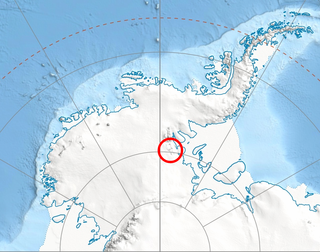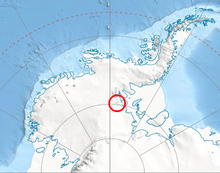The Reedy Glacier is a major glacier in Antarctica, over 100 nautical miles long and 6 to 12 nautical miles wide, descending from the polar plateau to the Ross Ice Shelf between the Michigan Plateau and Wisconsin Range in the Transantarctic Mountains. It marks the limits of the Queen Maud Mountains on the west and the Horlick Mountains on the east.
The Amundsen Glacier is a major Antarctic glacier, about 7 to 11 km wide and 150 km (80 nmi) long. It originates on the Antarctic Plateau where it drains the area to the south and west of Nilsen Plateau, then descends through the Queen Maud Mountains to enter the Ross Ice Shelf just west of the MacDonald Nunataks.
The Cook Mountains is a group of mountains bounded by the Mulock and Darwin glaciers in Antarctica. They are south of the Worcester Range and north of the Darwin Mountains and the Britannia Range.

Muir Peak is a conspicuous rock peak near the middle of Frazier Ridge in the Founders Peaks, Heritage Range. It was mapped by the United States Geological Survey (USGS) from surveys and U.S. Navy air photos from 1961 to 1966. It was named by the Advisory Committee on Antarctic Names (US-ACAN) for Hugh M. Muir, a United States Antarctic Research Program (USARP) auroral scientist and member of the winter party at the Plateau Station in 1966.
The Bermel Escarpment is a snow and rock escarpment, 15 nautical miles long, extending from the base of the Ford Massif to King Peak, in the Thiel Mountains of Antarctica. The escarpment drops 300 to 400 metres from the Antarctic Plateau to the ice surface north of these mountains.
The Gothic Mountains is a group of mountains, 20 nautical miles long, in the Queen Maud Mountains of Antarctica, located west of Watson Escarpment and bounded by Scott Glacier, Albanus Glacier, and Griffith Glacier.
Unger Peak is a conspicuous, mainly ice-covered peak which rises above the plateau at the south end of Founders Escarpment. It stands 2 nautical miles (3.7 km) north-northwest of Zavis Peak in the Heritage Range, Ellsworth Mountains. It was mapped by the United States Geological Survey (USGS) from surveys and U.S. Navy air photos from 1961 to 1966. It was named by the Advisory Committee on Antarctic Names (US-ACAN) for Lieutenant Maurice H. Unger of the U.S. Navy, a navigator on photographic flights over Marie Byrd and Ellsworth Lands during Operation Deep Freeze 1965 and 1966.
Navigator Peak is a sharp and prominent peak, 1,910 m, standing 4 nautical miles (7 km) east of Zavis Peak in the north part of the White Escarpment, Heritage Range. It was named by the University of Minnesota Geological Party to these mountains in 1963–64 because the peak served as a landmark to navigators and pilots returning to camp from flights in the southern part of the Heritage Range.
Nilsen Plateau is a rugged, ice-covered plateau in Antarctica. When including Fram Mesa, the plateau is about 30 nautical miles long and 1 to 12 nautical miles wide, rising to 3,940 metres (12,930 ft) high between the upper reaches of the Amundsen and Scott glaciers, in the Queen Maud Mountains. Discovered in November 1911 by the Norwegian expedition under Roald Amundsen, and named by him for Captain Thorvald Nilsen, commander of the ship Fram.
Watson Escarpment is a major escarpment in the Queen Maud Mountains, trending northward along the east margin of Scott Glacier, then eastward to Reedy Glacier where it turns southward along the glacier's west side. Somewhat arcuate, the escarpment is nearly 100 nautical miles long, rises 3,550 metres (11,650 ft) above sea level, and 1,000 to 1,500 metres above the adjacent terrain.

Webster Glacier is a glacier in the Founders Peaks of the Heritage Range, flowing generally north between Frazier Ridge and Pipe Peak to enter Minnesota Glacier. Mapped by United States Geological Survey (USGS) from surveys and U.S. Navy air photos, 1961–66. Named by Advisory Committee on Antarctic Names (US-ACAN) for Charles W. Webster, United States Antarctic Research Program (USARP) meteorologist and member of the winter party at Wilkes Station in 1963.
Strauss Glacier is a glacier, 40 nautical miles long, flowing between the Ickes Mountains and Coulter Heights to enter the sea at the east side of Land Bay, Marie Byrd Land, Antarctica.
Derrick Peak is a prominent ice-free peak, 2,070 metres (6,790 ft) high, overlooking the south side of Hatherton Glacier, 3 nautical miles west of the north end of Johnstone Ridge.
Founders Escarpment is a prominent escarpment located west of the Founders Peaks in the Heritage Range of Antarctica, extending from Minnesota Glacier to Splettstoesser Glacier. It was named after the nearby Founders Peaks by the University of Minnesota Geological Party, 1963–64.
Frazier Ridge is a sharp ridge on the west side of Webster Glacier, extending north from Founders Escarpment to Minnesota Glacier, in the Heritage Range of Antarctica. It was named by the University of Minnesota geological party, 1963–64, for Sergeant Herbert J. Frazier, a radioman with the 62nd Transportation Detachment who was of assistance to the party.

Mount Gardner is a mountain, 4,587 metres (15,050 ft) high, standing 1.5 nautical miles (3 km) west of Mount Tyree in the west-central part of the Sentinel Range, in the Ellsworth Mountains of Antarctica. It surmounts Patton Glacier to the northeast.
Mount Henderson is a prominent mountain. It is 2,660 metres (8,730 ft) high, and stands 5 nautical miles west of Mount Olympus in the Britannia Range of Antarctica. Discovered and named by the British National Antarctic Expedition, 1901-04.
Skelly Peak is a peak on the end of a spur, marking the northeast limit of Watlack Hills in the Heritage Range, Ellsworth Mountains. It was mapped by the United States Geological Survey (USGS) from ground surveys and U.S. Navy air photos from 1961 to 1966. It was named by the Advisory Committee on Antarctic Names (US-ACAN) for Donald J. Skelly, a hospital corpsman and U.S. Navy chief petty officer in charge of Palmer Station in 1966.

Rennell Glacier is a glacier, 10 nautical miles long, in the Pioneer Heights, Heritage Range. It drains northwest, to the east of Inferno Ridge, to join Splettstoesser Glacier. Named by the University of Minnesota Geological Party to these mountains, 1963–64, for K.P. Rennell, biologist with the party.
The Rawson Mountains lie within the Queen Maud Mountains to the southeast of the Ross Ice Shelf in Antarctica. They are a crescent-shaped range of tabular, ice-covered mountains including Fuller Dome, Mount Wyatt and Mount Verlautz, standing southeast of Nilsen Plateau and extending southeast for 18 nautical miles to the west side of Scott Glacier.


